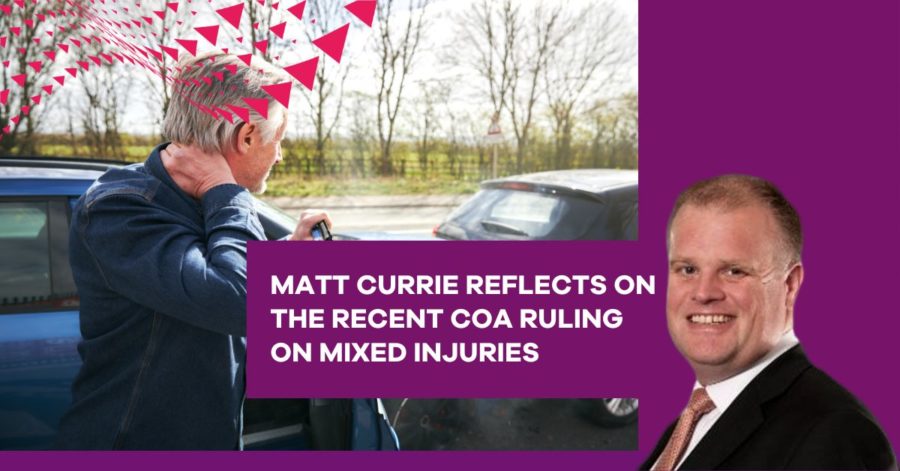
Following the 20th January COA ruling on the valuation of mixed injuries claims in the test cases of Rabot v Hassam and Briggs v Laditan, one might be forgiven for wondering ‘what has changed’?
As we now know, the majority of the court determined that the approach to an assessment of damages in respect of a tariff and non-tariff award where concurrently caused pain, suffering and loss of amenity (PSLA) is present is that the court should:
- assess the tariff award by reference to the regulations
- assess the award for non-tariff injuries on common law principles
- “step back” to carry out any necessary adjustment so as to avoid any possible overcompensation
Reflecting the approach taken in these test cases in the lower courts, the Court of Appeal decision supports the principle of discounting in cases of multi-site injuries that existed prior to the Civil Liability Act (CLA). There is however a subtle but never-the-less significant difference, in that the compensation for the secondary injury is, in effect, protected and the discount cannot exceed the value of the tariff award.
This is important because it protects against potentially perverse outcomes, whereby it may otherwise be viewed as financially advantageous to not claim for the tariff injury at all – effectively creating a system that discourage access to justice for genuine whiplash claimants.
Undoubtedly, some may view this ‘ring fencing’ of the secondary injury award as being more generous than was the case pre CLA. However, the reality is that a discount will still be applied to the overall damages, which is a significantly different position than had been argued before the court, that in effect the compensation for both injuries should be assessed separately and simply added together with no discount.
It remains to be seen whether this judgment will be appealed further. Some are of the view that this judgment supports uncertainty and represents a licence for claimants to “create” additional injuries. I don’t believe that the judgment will create an epidemic of additional injuries and here’s why.
Firstly, I think there needs to be a distinction between additional injuries per se and the anecdotal reports of increased incidence emanating as a result of this judgment. The CLA moved us on, from a world where the relative value of additional injuries was modest to the overall claim, to one where the value is proportionately more significant. The reforms themselves created an environment where there would be an increased awareness of minor additional injuries and it is hardly surprising that a greater number are now being actively identified. However, even then we must be cautious about any pre and post reform comparisons because identification of additional injuries pre reform was not necessarily as robust as it is now.
Turning to the impact of the Court of Appeal decision, presumably the fear is that innocuous injuries will be added to a claim that were not previously claimed (to maximise the recoverable damages). Significant secondary injuries have surely always been claimed and so there will be no claims inflation in that regard. The incentive for a claimant to “create” injuries is therefore a very modest one.
Another suggestion is that claimant lawyers or MROs are in some way being creative to either identify or falsify additional injuries. There is little to no advantage to an MRO taking such an approach. Minor additional injuries will not mean more medico legal reports are produced and adding any complexity is likely to harm the MROs business model – not help it.
From a law firm perspective, when operating under a CFA/DBA there is an opportunity to increase fees by 25% of the value of the additional injuries. However, 25% of a modest additional award is unlikely to materially alter profitability when the additional operating costs of additional injury cases are taken into account
It would be naive of me to suggest that no bad behaviour will exist, but I do not believe that in itself there will be sufficient incentive to create any material market change over and above what was caused by the reforms themselves. Where there is believed to be bad behaviour, data in relation to the source of the medico – legal reports when compared with the rest of the market should readily drive Medco to investigate further. Medco will however need the evidence.
The challenge for the industry, insurers and claimant lawyers alike is that for these multi-site claims, each valuation needs to be bespoke. This introduces the potential of drag into the process, which in turn delays the outcome for the consumer, increases costs for all parties involved and presents opportunities for friction.
Whilst claims from some quarters for greater clarity remain, the CoA’s ruling does provide a platform upon which those who want to limit friction can now work together, collaborating to find solutions which reduce the risk of friction and cost, whilst and accelerating outcomes for customers. One of the benefits of this judgment is that it provides at least some of the clarity required to allow us to work towards those solutions in a far more pragmatic way than has been the case thus far.



